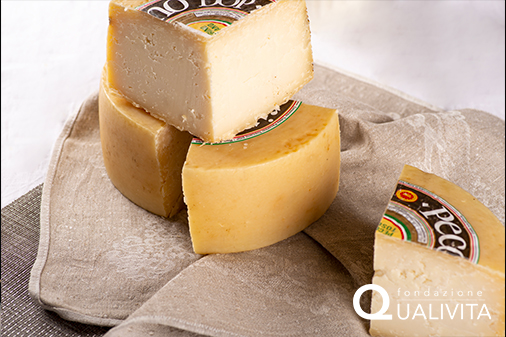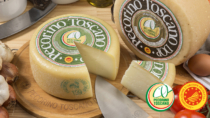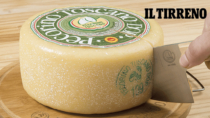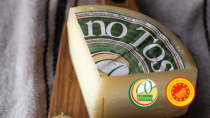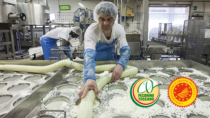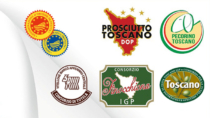Description
Pecorino Toscano PDO is a soft or semi-hard cheese produced with whole sheep’s milk. There are two typologies: Fresco (fresh, aged at least 20 days); Stagionato (mature, aged at least 4 months).
Production Area
The production area of Pecorino Toscano PDO is within the entire territory of the Tuscany region, and in some bordering municipalities in the provinces of Viterbo and Perugia, in the regions of Lazio and Umbria, respectively.
Production Method
The milk must be curdled at a temperature of between 33 and 38 °C, with the addition of calf or vegetarian rennet so that it curdles within 20-25 minutes. The milk can be raw or heat treated until it is pasteurized, and may be inoculated with native natural or selected probiotics. If the curd is going to be used to produce Pecorino Toscano PDO Stagionato, after it is broken it is heated to a temperature of 40-42 °C for 10-15 minutes. The curd is then placed in moulds to expel the whey. This is done by manual pressing or “stufatura” (a process using heat and steam). It is then dry salted or salted in brine; the length of time varies according to the weight of the wheel; on average, one for a wheel of Pecorino Toscano PDO Fresco remains in the salt for about 16 hours, while the pecorino Stagionato remains for about 24 hours. Pecorino Toscano PDO may be treated externally with an anti-mould agent, and must be ripened in suitable environments at a temperature of 5-15 °C, for a period of at least 20 days for the fresh cheese and no less than four months for the semi-hard cheese.
Appearance and Flavour
Pecorino Toscano PDO has a cylindrical shape, flat surfaces and a slightly convex heel. The diameter ranges from 15 to 22 cm and the weight can vary from 750 g to 3.5 kg. It is characterised by its yellow rind. The fresh cheese is compact, at times with minute eyes, soft on cutting and white to very pale straw-yellow in colour; the mature cheese is compact, firm on cutting, at times with minute unevenly distributed eyes, and ranges from pale straw-yellow to straw-yellow in colour. It has a fragrant, sweet and pronounced flavour that is never sapid or piquant, which is thanks to the production methods used.
History
It is said that the breeding of sheep in Tuscany dates back as far as the Etruscan period, but the first historical references to Tuscan pecorino are from the Roman period. In the 15th century it was known by the name of “cacio marzolino” (March cheese) because production began in March and continued throughout the Spring. This cheese has been produced according to specific production guidelines since the 19th century.
Gastronomy
Pecorino Toscano PDO is best kept in a cool, dry place. It is preferable not to put it in the refrigerator, but if it is, it should be placed in the least cold compartment and wrapped in a slightly damp cotton cloth. This product can be used as a table cheese or for grating, depending on how mature it is. It is delicious grated on Tuscan Ribollita soup, pasta dishes, or to add flavour to meat-based dishes. Both the Fresco and Stagionato varieties go well with fresh seasonal vegetables and fruit, jam and honey.
Marketing
The product is marketed year-round in the following typologies: Pecorino Toscano PDO Fresco (soft cheese, aged at least 20 days); Pecorino Toscano PDO Stagionato (semi-hard, aged at least four months). It is sold in whole wheels, segments of the wheel, or grated. The PDO mark is put on the heel, in ink for the Fresco variety, and fire-branded for the Stagionato variety. The wheels bear the words Pecorino Toscano PDO, a stylized P and T, and the producer’s identification number. Pecorino Toscano PDO cheese must also bear the label approved by the Protection Consortium.
Distinctive Features
Pecorino Toscano PDO is characterised by its sweet flavour that is never sapid or piquant. This distinctive trait is given to the use of calf or vegetarian rennet in the processing method, and to the shorter salting process compared to other varieties of pecorino cheese.





